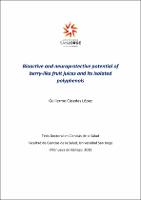Por favor, use este identificador para citar o enlazar este ítem:
https://repositorio.usj.es/handle/123456789/413
Registro completo de metadatos
| Campo DC | Valor | Lengua/Idioma |
|---|---|---|
| dc.contributor.advisor | Cásedas, Guillermo | - |
| dc.contributor.advisor | López Ramos, Víctor | - |
| dc.contributor.advisor | Smith, Carine | - |
| dc.contributor.author | Cásedas, Guillermo | - |
| dc.date.accessioned | 2020-10-16T09:55:08Z | - |
| dc.date.available | 2020-10-16T09:55:08Z | - |
| dc.date.issued | 2020 | - |
| dc.date.submitted | 2020-03-13 | - |
| dc.identifier.uri | https://repositorio.usj.es/handle/123456789/413 | - |
| dc.description | Some fruits such as blueberries, cranberries, cherries and juices that are made from them are important sources of nutrients and bioactive compounds such as polyphenols. Phytochemicals are known to be natural antioxidants that can modulate the activity of key enzymes involved in physiological functioning of the central nervous system and peripheral tissues. Specifically, anthocyanins stand out as major polyphenolic compound group that confer their characteristic colour to red fruits. The objective of this doctoral thesis focused on evaluating the antioxidant and cytoprotective capacity of blueberry (Vaccinium myrtillus L.), American cranberry (Vaccinium macrocarpon A.) and cherry (Prunus cerasus L.) juices, as well as their isolated polyphenols (cyanidin-3-O-glucoside, chlorogenic acid and cyanidin) or metabolites (urolithin A). These activities were determined by different methodologies through in vitro assays; the antioxidant capacity was established through DPPH· and superoxide radical assays; the neuroprotective potential was evaluated using central nervous enzymes: MAO-A, tyrosinase and AChE; in addition, the antidiabetic potential of these extracts via inhibiting enzymes that are currently pharmacological targets for the treatment of type II diabetes – α-glucosidase and dipeptidyl peptidase-4 – were assessed. After these trials, the neuroprotective activity of these juices and their isolated polyphenols was assessed in neuronal and glial models. Juices and cyanidin were tested on the SH-SY5Y neuronal line under conditions of induced oxidative stress. On the other hand, both chlorogenic acid and cyanidin were chosen for evaluation in a neuroinflammation model in U-373 glial cells treated with lipopolysaccharide. Finally, urolithin A was evaluated as a neuroprotective agent in Neuro-2a cells. Prior to any test, physiological concentrations of the extracts were tested to assess whether there was any cytotoxicity. The results obtained confirmed a high content of polyphenols in the juices, as well as a great antioxidant activity in the different bioassays. As for their properties, they showed the ability to inhibit enzymes related to the central nervous system and diabetes. In neuronal models, both juices, cyanidin and urolithin A were able to reduce the generation of reactive oxygen species and lipid peroxidation and increase the activity of antioxidant physiological systems (catalase, superoxide dismutase, glutathione reductase and peroxidase). In the glial model, chlorogenic acid and cyanidin reduced the secretion of pro-inflammatory cytokines at low doses while at high doses their mechanism of action remains unclear as they could act as pro-oxidants. Based on the results derived from the clinical trials previously described in the literature, these findings conclude that the juices of Vaccinium myrtillus, Vaccinium macrocarpon and Prunus cerasus are a source of polyphenols, mainly anthocyanins, which are of interest as potentially neuroprotective agents capable of reducing oxidative stress. | es_ES |
| dc.description.abstract | Algunos frutos como los arándanos, las cerezas y los zumos que se elaboran a partir de ellos son una fuente importante de nutrientes y compuestos bioactivos como, por ejemplo, polifenoles. Estos fitoquímicos son conocidos por ser antioxidantes naturales que pueden modular la actividad de enzimas claves involucradas en algunas funciones fisiológicas del sistema nervioso central y de tejidos periféricos. Concretamente, en estos frutos destacan las antocianinas como polifenoles más representativos puesto que son los responsables de los colores característicos. | es_ES |
| dc.format.extent | 122 p. (sin el compendio de artículos) | es_ES |
| dc.format.mimetype | application/pdf | es_ES |
| dc.language.iso | eng | es_ES |
| dc.language.iso | Español | es_ES |
| dc.relation.requires | Adobe PDF | es_ES |
| dc.rights | Attribution-NonCommercial-NoDerivatives 4.0 Internacional | * |
| dc.rights.uri | http://creativecommons.org/licenses/by-nc-nd/4.0/ | * |
| dc.subject | Antioxidantes en los alimentos | es_ES |
| dc.subject | Farmacología | es_ES |
| dc.subject | Redes neuronales | es_ES |
| dc.subject | Farmacognosia | es_ES |
| dc.title | Bioactive and neuroprotective potential of berry-like fruit juices and its isolated polyphenols | es_ES |
| dc.title.alternative | Potencial bioactivo y neuroprotector de zumos de bayas y sus polifenoles aislados | es_ES |
| dc.type | info:eu-repo/semantics/doctoralThesis | es_ES |
| dc.subject.unesco | Farmacología | es_ES |
| dc.subject.unesco | Tesis | es_ES |
| dc.rights.accessrights | info:eu-repo/semantics/openAccess | es_ES |
| Aparece en las colecciones: | Facultad de Ciencias de la Salud | |
Ficheros en este ítem:
| Fichero | Descripción | Tamaño | Formato | |
|---|---|---|---|---|
| Bioactive and neuroprotective potential.pdf | 15,88 MB | Adobe PDF |  Visualizar/Abrir |
Este ítem está sujeto a una licencia Creative Commons Licencia Creative Commons

